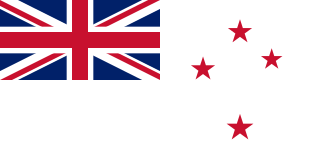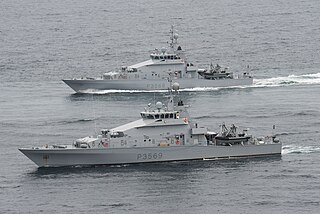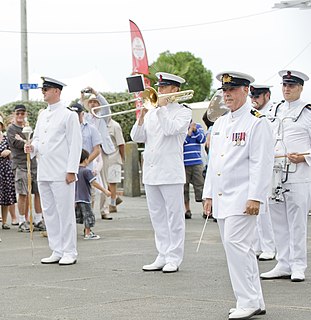
The Royal New Zealand Navy is the maritime arm of the New Zealand Defence Force. The fleet currently consists of nine ships.

HMNZS Resolution (A14) was a hydrographic ship of the Royal New Zealand Navy (RNZN). Originally the United States Naval Ship USNS Tenacious (T-AGOS-17), the Stalwart-class ocean surveillance ship was used by the United States to locate and track Soviet submarines from 1989 to 1997, when she was transferred to the RNZN for use as a hydrographic survey ship. She served until 27 April 2012. She was subsequently sold to EGS Group, a private surveying company, and renamed RV Geo Resolution.

HMNZS Wellington was a Leander-class frigate of the Royal Navy and the Royal New Zealand Navy (RNZN). Originally commissioned in 1969 for the Royal Navy as HMS Bacchante, she joined the RNZN in 1982. She was decommissioned in 1999 and sunk in 2005.

The Moa-class patrol boat was a class of patrol boats built between 1978 and 1985 for the Royal New Zealand Navy by the Whangarei Engineering and Construction Company. They were based on an Australian boat design.

The Protector-class offshore patrol vessel is a ship class of two offshore patrol vessel (OPVs) operated by the Royal New Zealand Navy (RNZN) since 2010. The ships are named HMNZS Otago and HMNZS Wellington.

The history of the Royal New Zealand Navy leads back to early New Zealand-based gunboats used in controlling the British interests in the new colony, as well as to the strong linkages to the British Navy itself.

The Lake-class inshore patrol vessel is a ship class of inshore patrol vessels (IPVs) of the Royal New Zealand Navy (RNZN) and the Irish Naval Service which replaced the RNZN's Moa-class patrol boats in 2007–2008. All four vessels are named after New Zealand lakes.
HMNZS Waikato (F55) was a Leander Batch 2TA frigate of the Royal New Zealand Navy (RNZN). She was one of two Leanders built for the RNZN, the other being the Batch 3 HMNZS Canterbury. These two New Zealand ships relieved British ships of the Armilla patrol during the Falklands conflict, freeing British ships for deployment.
HMNZS Tui, formerly USNS Charles H. Davis (T-AGOR-5), was one of nine Conrad class oceanographic ships built for the United States Navy (USN), that later saw service in the Royal New Zealand Navy (RNZN). Serving with the USN from 1963 to 1970, these ships were designed to perform acoustic experiments on sound transmission underwater, and for gravity, magnetism and deep-ocean floor studies.

HMNZS Otago (P148) is a Protector-class offshore patrol vessel in service with the Royal New Zealand Navy. The development of the OPV design based on an Irish Naval Service OPV class was very contentious with the RNZN arguing for the need for a limited combat suite for effective training and patrol work with a 57 mm-76 mm light frigate gun and associated fire control and radar and electronic warfare systems at least compatible with current 2nd light RN OPVs while the government and Cabinet preference was to use the space and extra finance available to incorporate ice strengthening and provision of extra coastal patrol vessels. The RNZN view was that adding ice strengthening was unnecessary for Southern Ocean patrol as distinct from operation in the Ross sea and the extra weight and complexity would stress and shorten the life of the hulls from 25 to 15 years She was launched in 2006 but suffered from problems during construction and was not commissioned until 2010, two years later than planned. Soon after commissioning Otago encountered problems with both her engines which delayed her arrival at her home port of Port Chalmers. She has served on several lengthy patrols of the Antarctic, though she lacks the capability to operate in heavier levels of ice-coverage which has led to the cancellation of at least one planned operation.

HMNZS Wakakura (P3555) was a Moa-class inshore patrol vessel of the Royal New Zealand Navy. It was commissioned in March 1985 for the Naval Volunteer Reserve.
HMNZS Taupo was a Lake-class patrol vessel of the Royal New Zealand Navy. Taupo was commissioned in 1975 and decommissioned in 1991, serving for 16 years.
HMNZS Wakakura (T00) was originally a First World War Castle-class naval trawler built in Canada. Ordered by the Admiralty, the vessel, named TR 1, was loaned to the Royal Canadian Navy for use on the East Coast of Canada. She was purchased by New Zealand in 1926 and transferred to the Royal New Zealand Navy when it was established in 1941.

HMNZS Canterbury (F421) was one of two broad beam Leander-class frigates operated by the Royal New Zealand Navy (RNZN) from 1971 to 2005. She was built in Scotland and launched in 1970. Commissioned in 1971, Canterbury saw operational service in much of Australasia and other regions like the Persian Gulf. She undertook operations such as supporting UN sanctions against Iraq and peace-keeping in East Timor. With her sister ship HMNZS Waikato she relieved the Royal Navy frigate HMS Amazon in the Indian Ocean during the Falklands War. Early in HMNZS Canterbury's career, in 1973, she relieved the frigate HMNZS Otago, as part of a unique, Anzac, naval operation or exercise at Moruroa during anti-nuclear protests, supported by a large RAN tanker, providing fuel and a large platform for Australian media. This was due to F 421 being a more modern RNZN frigate, with then current Rn surveillance radar and ESM and a more effectively insulated frigate from nuclear fallout, with the Improved Broad Beam Leander steam plant, for example, being remote controlled and capable of unmanned operation and therefore the ship provided a more effective sealed citadel for operations in areas of nuclear explosions.
HMNZS Moa (T233) was a Bird class minesweeper of the Royal New Zealand Navy (RNZN) that served during World War II.

The New Zealand Division of the Royal Navy also known as the New Zealand Station was formed in 1921 and remained in existence until 1941. It was the precursor to the Royal New Zealand Navy. Originally, the Royal Navy was solely responsible for the naval security of New Zealand. The passing of the Naval Defence Act 1913 created the New Zealand Naval Forces as a separate division within the Royal Navy.
The Royal New Zealand Naval Volunteer Reserve (RNZNVR) is the volunteer reserve force of the Royal New Zealand Navy (RNZN).
HMNZS Santon (M1178) was a Ton class minesweeper that operated in the Royal Navy, the Royal New Zealand Navy (RNZN), and the Argentine Navy.
HMNZS Hickleton (M1131) was a Ton class minesweeper that operated in the Royal Navy and the Royal New Zealand Navy (RNZN). She was named after a small village near Doncaster.

The Royal New Zealand Navy Band is the musical arm of the Royal New Zealand Navy, serving its musical needs from its headquarters at HMNZS Philomel on Devonport Naval Base, North Shore City, Auckland.
This page is based on this
Wikipedia article Text is available under the
CC BY-SA 4.0 license; additional terms may apply.
Images, videos and audio are available under their respective licenses.










